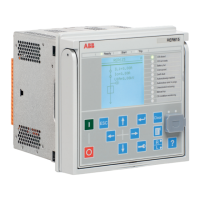In compensated and isolated neutral systems, the system neutral voltage, that is,
the residual voltage, increases in case of any fault connected to earth. Depending on
the type of the fault and the fault resistance, the residual voltage reaches different
values. The highest residual voltage, equal to the phase-to-earth voltage, is achieved
for a single-phase earth fault. The residual voltage increases approximately the
same amount in the whole system and does not provide any guidance in finding the
faulty component. Therefore, this function is often used as a backup protection or
as a release signal for the feeder earth-fault protection.
The protection can also be used for the earth-fault protection of generators and
motors and for the unbalance protection of capacitor banks.
The residual voltage can be calculated internally based on the measurement of the
three-phase voltage. This voltage can also be measured by a single-phase voltage
transformer, located between a transformer star point and earth, or by using an
open-delta connection of three single-phase voltage transformers.
4.4.3.6 Signals
Table 451: ROVPTOV Input signals
Name Type Default Description
Uo SIGNAL 0 Residual voltage
BLOCK BOOLEAN 0=False Block signal for acti-
vating the blocking
mode
Table 452: ROVPTOV Output signals
Name Type Description
OPERATE BOOLEAN Operate
START BOOLEAN Start
4.4.3.7 Settings
ROVPTOV Group settings
Table 453: ROVPTOV Group settings (Basic)
Parameter
Values (Range) Unit Step Default Description
Start value 0.010...1.000 xUn 0.001 0.030 Residual overvolt-
age start value
Operate delay time 40...300000 ms 1 40 Operate delay time
Table 454: ROVPTOV Non group settings (Basic)
Parameter
Values (Range) Unit Step Default Description
Operation
1=on
5=off
1=on Operation Off / On
Uo signal Sel
1=Measured Uo
2=Calculated Uo
1=Measured Uo Selection for used
Uo signal
Protection functions 1MRS758755 C
438 REC615 & RER615
Technical Manual

